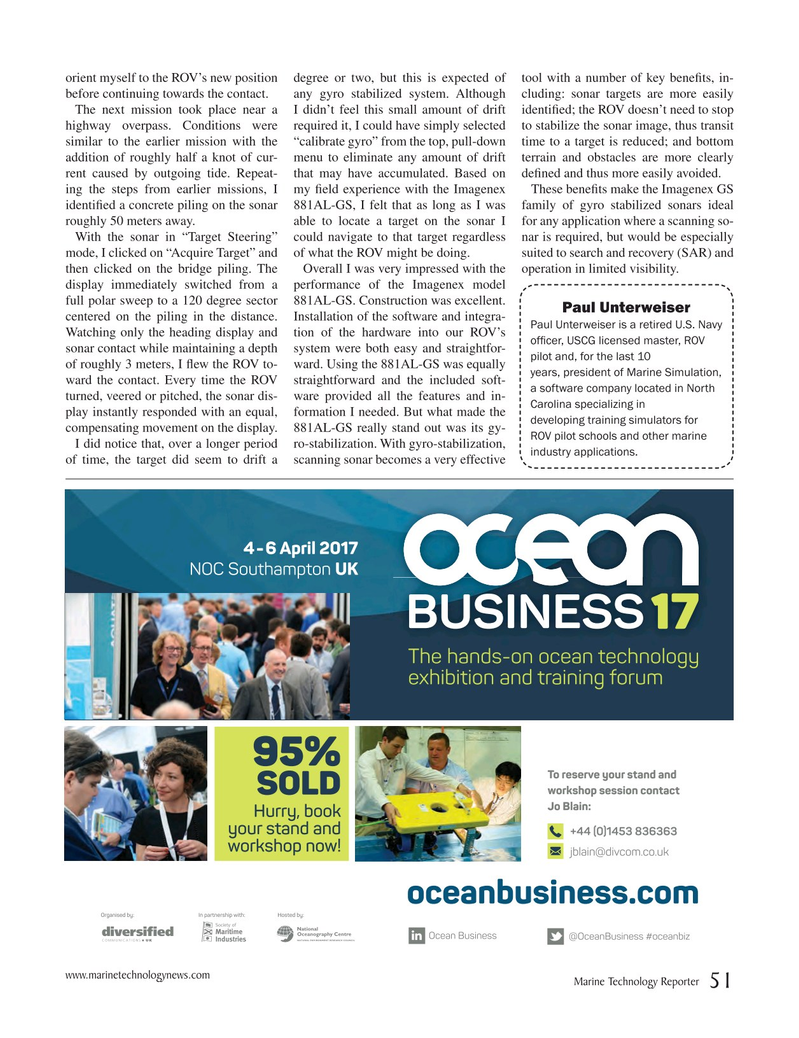
Page 51: of Marine Technology Magazine (September 2016)
Ocean Observation: Gliders, Buoys & Sub-Surface Networks
Read this page in Pdf, Flash or Html5 edition of September 2016 Marine Technology Magazine
orient myself to the ROV’s new position degree or two, but this is expected of tool with a number of key bene? ts, in- before continuing towards the contact. any gyro stabilized system. Although cluding: sonar targets are more easily
The next mission took place near a I didn’t feel this small amount of drift identi? ed; the ROV doesn’t need to stop highway overpass. Conditions were required it, I could have simply selected to stabilize the sonar image, thus transit similar to the earlier mission with the “calibrate gyro” from the top, pull-down time to a target is reduced; and bottom addition of roughly half a knot of cur- menu to eliminate any amount of drift terrain and obstacles are more clearly rent caused by outgoing tide. Repeat- that may have accumulated. Based on de? ned and thus more easily avoided.
ing the steps from earlier missions, I my ? eld experience with the Imagenex These bene? ts make the Imagenex GS identi? ed a concrete piling on the sonar 881AL-GS, I felt that as long as I was family of gyro stabilized sonars ideal roughly 50 meters away. able to locate a target on the sonar I for any application where a scanning so-
With the sonar in “Target Steering” could navigate to that target regardless nar is required, but would be especially mode, I clicked on “Acquire Target” and of what the ROV might be doing. suited to search and recovery (SAR) and then clicked on the bridge piling. The Overall I was very impressed with the operation in limited visibility.
display immediately switched from a performance of the Imagenex model full polar sweep to a 120 degree sector 881AL-GS. Construction was excellent.
Paul Unterweiser centered on the piling in the distance. Installation of the software and integra-
Paul Unterweiser is a retired U.S. Navy
Watching only the heading display and tion of the hardware into our ROV’s of? cer, USCG licensed master, ROV sonar contact while maintaining a depth system were both easy and straightfor- pilot and, for the last 10 of roughly 3 meters, I ? ew the ROV to- ward. Using the 881AL-GS was equally years, president of Marine Simulation, ward the contact. Every time the ROV straightforward and the included soft- a software company located in North turned, veered or pitched, the sonar dis- ware provided all the features and in-
Carolina specializing in play instantly responded with an equal, formation I needed. But what made the developing training simulators for compensating movement on the display. 881AL-GS really stand out was its gy-
ROV pilot schools and other marine
I did notice that, over a longer period ro-stabilization. With gyro-stabilization, industry applications.
of time, the target did seem to drift a scanning sonar becomes a very effective 4 6 April 2017–
NOC Southampton UK
The hands-on ocean technology exhibition and training forum 95%
To reserve your stand and workshop session contact
SOLD
Jo Blain:
Hurry, book your stand and +44 (0)1453 836363 workshop now!
[email protected] oceanbusiness.com
In partnership with: Organised by: Hosted by:
Ocean Business @OceanBusiness #oceanbiz www.marinetechnologynews.com
Marine Technology Reporter 51
MTR #7 (50-64).indd 51 8/24/2016 2:38:11 PM

 50
50

 52
52
